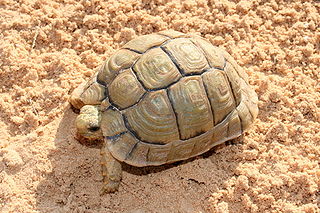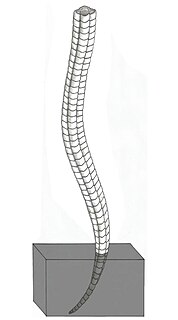
The threadfin rainbowfish or featherfin rainbowfish is a rainbowfish, the only species in the genus Iriatherina. It is characterized by long beautiful fins, and is among the most attractive of the rainbowfishes.

Franz Josef Maria Werner was an Austrian zoologist and explorer. Specializing as a herpetologist and entomologist, Werner described numerous species and other taxa of frogs, snakes, insects, and other organisms.

The Negev tortoise is a species of tortoise in the family Testudinidae. The species is endemic to the Negev Desert in southern Israel.
The Bailey's treefrog is a species of frog in the family Hylidae. It is endemic to southern Brazil. Its natural habitats are subtropical or tropical seasonally wet or flooded lowland grassland, swamps, freshwater marshes, intermittent freshwater marshes, pastureland, and seasonally flooded agricultural land.
Phrynobatrachus werneri is a species of frog in the family Phrynobatrachidae. It is only known with certainty from western Cameroon, although there is a putative record from Chappal Waddi in Nigeria, close to the border of Cameroon; the earlier record from the Obudu Plateau in Nigeria is now assigned to Phrynobatrachus schioetzi described as a new species in 2011. The status of Phrynobatrachus manengoubensis from Mount Manengouba remains unclear, with some questioning its distinctness from Phrynobatrachus werneri. Common name Werner's river frog has been coined for this species.
Achalinus werneri is a species of snake in the family Xenodermatidae. The species is endemic to the Ryukyu Islands, Japan. No subspecies are currently recognized.
The spatula-toothed snake is a species of snake in the family Colubridae. The species is endemic to Indonesia.
The Brazilian radiolated swamp turtle is a species of turtle in the Chelidae family endemic to Brazil.

Lithops werneri is a species of plant in the family Aizoaceae. It is endemic to Namibia. Its natural habitat is rocky areas.
Petalium werneri is a species of beetle in the family Ptinidae.
Niveria werneri is a species of small sea snail, a marine gastropod mollusk in the family Triviidae, the false cowries or trivias.
Aparallactus werneri, or the Usambara centipede-eater, is a species of venomous rear-fanged snake in the family Atractaspididae.
Hysterocladia is a genus of moth in the family Megalopygidae.

Corumbella is an extinct genus of terminal-Ediacaran cnidarians. It is the only genus in the monotypic family Corumbellidae, and is represented by a single species Corumbella werneri. It possessed a carapace made up of thick polygonal rings in which plates with pores and papillae attest to the advent of skeletogenesis in latest Neoproterozoic metazoan. It was a sessile predator and somewhat resembles the later conulariids.
Neocompsa werneri is a species of beetle in the family Cerambycidae. It was described by Martins in 1970.
Epaphroditini is a tribe of the family Hymenopodidae. It has the following members:
Cephalocladia fulvicornis is a moth of the Megalopygidae family. It was described by Paul Dognin in 1923. It is found in Brazil.
Cephalocladia mossi is a moth of the family Megalopygidae. It was described by Walter Hopp in 1927. It is found in Brazil.
Hysterocladia werneri is a moth of the family Megalopygidae. It was described by Walter Hopp in 1927. It is found in Colombia.
Neopsammodius werneri is a species of aphodiine dung beetle in the family Scarabaeidae. It is found in Central America and North America.






